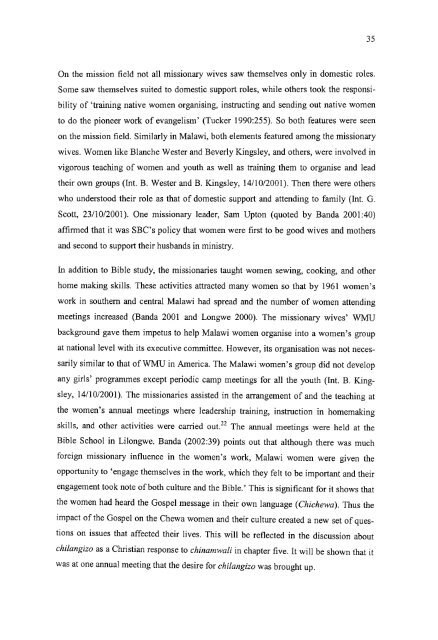FROM CHINAMWALI TO CHILANGIZO:
FROM CHINAMWALI TO CHILANGIZO:
FROM CHINAMWALI TO CHILANGIZO:
You also want an ePaper? Increase the reach of your titles
YUMPU automatically turns print PDFs into web optimized ePapers that Google loves.
On the mission field not all missionary wives saw themselves only in domestic roles.<br />
Some saw themselves suited to domestic support roles, while others took the responsi<br />
bility of 'training native women organising, instructing and sending out native women<br />
to do the pioneer work of evangelism' (Tucker 1990:255). So both features were seen<br />
on the mission field. Similarly in Malawi, both elements featured among the missionary<br />
wives. Women like Blanche Wester and Beverly Kingsley, and others, were involved in<br />
vigorous teaching of women and youth as well as training them to organise and lead<br />
their own groups (lnt. B. Wester and B. Kingsley, 14/10/2001). Then there were others<br />
who understood their role as that of domestic support and attending to family (lnt. G.<br />
Scott, 23/10/2001). One missionary leader, Sam Upton (quoted by Banda 2001:40)<br />
affirmed that it was SBC's policy that women were first to be good wives and mothers<br />
and second to support their husbands in ministry.<br />
In addition to Bible study, the missionaries taught women sewing, cooking, and other<br />
home making skills. These activities attracted many women so that by 1961 women's<br />
work in southern and central Malawi had spread and the number of women attending<br />
meetings increased (Banda 2001 and Longwe 2000). The missionary wives' WMU<br />
background gave them impetus to help Malawi women organise into a women's group<br />
at national level with its executive committee. However, its organisation was not neces<br />
sarily similar to that ofWMU in America. The Malawi women's group did not develop<br />
any girls' programmes except periodic camp meetings for all the youth (lnt. B. King<br />
sley, 14/10/2001). The missionaries assisted in the arrangement of and the teaching at<br />
the women's annual meetings where leadership training, instruction in homemaking<br />
skills, and other activities were carried OUt. 22 The annual meetings were held at the<br />
Bible School in Lilongwe. Banda (2002:39) points out that although there was much<br />
foreign missionary influence in the women's work, Malawi women were given the<br />
opportunity to 'engage themselves in the work, which they felt to be important and their<br />
engagement took note ofboth culture and the Bible.' This is significant for it shows that<br />
the women had heard the Gospel message in their own language (Chichewa). Thus the<br />
impact ofthe Gospel on the Chewa women and their culture created a new set of ques<br />
tions on issues that affected their lives. This will be reflected in the discussion about<br />
chilangizo as a Christian response to chinamwali in chapter five. It will be shown that it<br />
was at one annual meeting that the desire for chilangizo was brought up.<br />
35

















